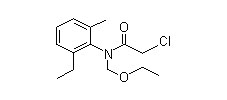|
Acetochlor
|
|
Chemical name: |
Acetochlor |
|
CAS No.: |
34256-82-1
|
|
Empirical formula: |
C14H20ClNO2
|
|
Structural formula: |
 |
|
Molecular mass: |
269.8 |
|
Basic chemical and physical data: |
The pure Acetochlor is slight yellow liquid, Acetochlor technical is brown or brown-red liquid. M.p. <0℃, b.p. >200℃, f.p. >68℃ (133.3Pa), density (20℃) 1.1358g/cm3; (30) 1.11g/cm3. Vapor pressure (25℃) 4.53nPa. Solubility in water: 398mg/L (20℃); it is steadily soluble in most organic solvents such as benzene, ethanol, acetone, chloroform, toluene, ethyl acetate etc. Non-volatile, non-photolysis. |
|
Usage: |
: Acetochlor is a selective herbicide used for control of most annual grasses and certain broadleaf weeds. It can be used on maize, cotton, peanuts, corn, soybeans, onion, green peas, potatoes, sunflower, vineyards etc. Acetochlor is applied pre-emergence, pre-plant incorporated and is compatible with most other pesticides and fluid fertilizers when used at recommended rates. |
|
Toxicity: |
The acute oral LD50 for rats is 2148mg/kg, the acute dermal LD50 is 4166mg/kg in rabbits. It is slightly irritant to skin and eyes in rabbits. Birds toxicity LD50: 1590mg/kg in quail, 5600mg/kg in duc |
|
Storage: |
Acetochlor shall be stored in a cool, dry and well ventilated place. It should not be stored or transported along with foods. |
|
Package: |
200L drum, or according to the customer’s requirements. |
|
Attention: |
1. Acetochlor must be applied before the budding of weeds; choose the dose rate according to various region and different season, and depending on the humidity of soil and content of organic matters.
2. Acetochlor is not suitable for the application in the fields of cucumber, rice, spinach, wheat, leek, corn, sorghum etc., as these crops are sensitive to Acetochlor.
|
|
Formulation: |
900g/L EC;40%WP |
|
|
|
|
Specification of technical: |
|
|
Appearance: Brown or brown-red liquid
Content of A.I.: 93.0% min.
Moisture: 0.3% max.
Acidity: 0.2% max. |
|